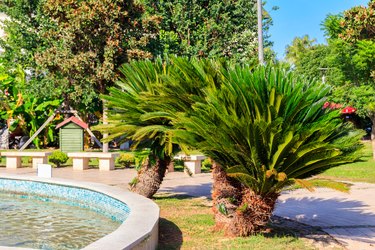
The pygmy date palm (Phoenix roebelinii), though not stately like its taller cousins, appears hairy, feathery and friendly. Most pygmy dates grow in groups of three, but that isn't its natural state, just one created at the garden center to make the presentation more dramatic. There are many types of date palm trees, but the pygmy is the shortest, growing 6 to 10 feet in height. Pygmy date palm pruning takes place when needed but is best during the warmer months to give the tree time to recover and grow.
Taking Care of a Pygmy Date Palm
Video of the Day
Favoring a sunny climate, the pygmy date palm flourishes in U.S. Department of Agriculture plant hardiness zones 10 to 11 and at maturity can tolerate cold down to 15 degrees Fahrenheit. Originating in southeast Asia and the forests of Africa, the pygmy thrives closer to the ground and in indirect sunlight. Care is minimal, and the best thing you can do for your pygmy is to keep its roots moist but not soaking. A weekly watering should be sufficient.
Video of the Day
Good drainage is also essential to growing a healthy pygmy date palm. Whether it is in a container or the ground, drainage is one of the main considerations when positioning your tree. It also needs fertilization, especially in the main growing months of spring and summer, and sun passing through its dense growth is essential and dictates when pygmy date palm pruning should take place.
Pygmy Date Palm Pruning
When you look at your cluster of pygmy date palms and see fronds that are turning brown, they need to be trimmed because they are draining essential nutrients that the healthy fronds need. The old fronds hanging down over the trunk are not only unsightly but they attract disease and pests. Start at the bottom of the trunk and remove one leaf at a time using sterilized pruning shears.
Work your way up the tree trunk until you reach healthy fronds. Then, it's time to work on the trunk. Pygmy date palm trunk cleaning removes the leftover debris from the leaves and their fibers. They are unattractive and should be removed, revealing an interesting pattern on the trunk. Moving closer to the top, a pineapple shape is revealed, bringing more intricacy to the trunk of the pygmy palm. If your tree is sporting a fruit or flower cluster, it too can be trimmed.
Analyzing Your Pruning Technique
When you've finished a round of pruning, step back and analyze whether the symmetry of the tree is intact. Look at the crown of the tree and imagine a clock. The leaves should all be within the 9:00 to 3:00 range. If any fronds fall below those guidelines, remove them.
Look at your trimming sites and be sure the cuts are clean and close to the trunk. Overpruning stunts the tree's growth and removes its protection from disease and insects. Wear gloves and goggles since the fronds have tiny spikes that can fly off the fronds and into your eyes.